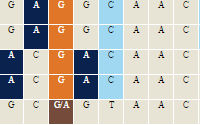Distribution of organic anion-transporting polypeptide 2 (oatp2) and oatp3 in the rat retina. |
| Authors: |
Ito, A Yamaguchi, K Onogawa, T Unno, M Suzuki, T Nishio, T Suzuki, Takashi Sasano, Hironobu Abe, Takaaki Tamai, Makoto
|
| Citation: |
Ito A, etal., Invest Ophthalmol Vis Sci 2002 Mar;43(3):858-63. |
| RGD ID: |
70527 |
| Pubmed: |
PMID:11867608 (View Abstract at PubMed) |
PURPOSE: To examine the expression of multifunctional Na(+)-independent organic anion-transporting polypeptides, termed oatp1, oatp2, and oatp3, involving the transport of thyroid hormone in the rat retina at the protein and mRNA levels. METHODS: Northern blot analysis was performed using oatp1, -2, and -3 cDNAs. Reverse transcription-polymerase chain reaction (RT-PCR) was also performed using gene-specific primers for oatp1, -2, and -3. mRNA distribution of these oatps in the rat retina was examined by in situ hybridization. Western blot analysis and immunohistochemistry were also performed by raising specific antibodies against oatp2 and -3. RESULTS: Northern blot analysis showed that the mRNAs for oatp2 and -3 were expressed in the rat retina and retinal pigment epithelium (RPE). Amplified cDNA products by RT-PCR for oatp2 and -3 were also detected in the rat retina-RPE. In contrast, no specific band for oatp1 was detected by Northern blot analysis or RT-PCR. By in situ hybridization, oatp2-specific mRNA signals were seen in the RPE and inner nuclear layer, whereas the oatp3 mRNA signal was localized to the ganglion cell. At the protein level, a single band for oatp2 and -3 proteins was detected in the rat retina-RPE by Western blot analysis. Immunohistochemistry revealed that oatp2 immunostaining was predominantly expressed at the apical surface of the RPE. Weak immunostaining for oatp2 was also seen in the inner nuclear layer and the ganglion cell layer. In contrast, apparent immunostaining for oatp3 was seen in the nerve fiber layer, ganglion cell layer, inner plexiform layer, and outer aspect of the inner nuclear layer. In addition, oatp3 immunostaining was detected predominantly in the optic nerve fiber. CONCLUSIONS: These results reveal that oatp2 is localized mainly in the RPE, suggesting a role for organic anion transport in this specialized ocular tissue. In contrast, oatp3 is localized mainly in optic nerve fibers, suggesting that oatp3 is a specific transporter in the visual nervous system. In conclusion, these data suggest that oatp2 and -3 may be involved in the transport of thyroid hormone in the rat retina.
|
|




















